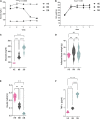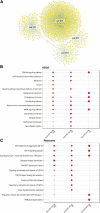Anthocyanin-rich extract from black beans exerts anti-diabetic effects in rats through a multi-genomic mode of action in adipose tissue
- PMID: 36451736
- PMCID: PMC9702351
- DOI: 10.3389/fnut.2022.1019259
Anthocyanin-rich extract from black beans exerts anti-diabetic effects in rats through a multi-genomic mode of action in adipose tissue
Abstract
Black beans (BB) are an important source of a range of plant bioactive compounds including polyphenols, particularly anthocyanins. Several studies support that consumption of BB is associated with health benefits, including prevention of type 2 diabetes mellitus (T2DM). However, molecular mechanisms underlying the potential health properties of BB on adipose tissue (AT) are still largely unknown. The purpose of this study was to investigate multi-genomic effects of BB intake and identify regulatory networks potentially mediating T2DM on AT. Male Wistar diabetic rats consumed an anthocyanin-rich black bean extract for 5 weeks. Global gene expression from AT, protein coding and non-coding RNA profiles were determined using RNAseq. Biological function analyses were performed using a variety of bioinformatic tools. The evaluation of global gene expression profiles exhibited significant change following BB consumption with 406 significantly differentially expressed genes, 33 miRNA and 39 lncRNA and 3 snRNA. Functional analyses indicated that these genes play an important role in regulation of PI3K signaling, NIN/NF-kB signaling, insulin secretion, and endoplasmic reticulum (ER) organization. Interestingly, transcription factors such as GATA2, or POU2AF1 demonstrated to modulate their activity by BB extract by direct interaction with polyphenol metabolites, or by interactions with cell signaling proteins, like PKB, AKT or PI3K, that could control transcription factor activity and as a result impact on adipogenesis regulation. Therefore, the constant consumption of an anthocyanin-rich black bean extract may have anti-diabetic protective effects by modulating gene expression, resulting in a promising alternative for T2DM patients.
Keywords: adipose tissue; anthocyanins; black beans; multi-genomics; nutrigenomics; polyphenols; type 2 diabetes mellitus.
Copyright © 2022 Damián-Medina, Milenkovic, Salinas-Moreno, Corral-Jara, Figueroa-Yáñez, Marino-Marmolejo and Lugo-Cervantes.
Conflict of interest statement
The authors declare that the research was conducted in the absence of any commercial or financial relationships that could be construed as a potential conflict of interest.
Figures








References
-
- World Health Organization. Diabetes Facts & Figures. Geneva: World Health Organization; (2021).
LinkOut - more resources
Full Text Sources
Molecular Biology Databases
Miscellaneous

